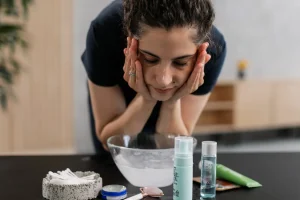Post-Inflammatory Hyperpigmentation Solutions for Deeper Skin Tones
3 min read
Let’s be real—dealing with post-inflammatory hyperpigmentation (PIH) can feel like playing whack-a-mole. You treat one dark spot, and another pops up. For those with deeper skin tones, the struggle is even more pronounced. Melanin-rich skin is more prone to stubborn discoloration after acne, cuts, or even just a rogue mosquito bite. But here’s the deal: PIH isn’t a life sentence. With the right approach, you can fade those marks and reclaim even-toned skin.
Why Deeper Skin Tones Are More Prone to PIH
It all comes down to melanin—the pigment that gives skin its color. Darker skin has more active melanocytes (the cells that produce melanin), which means inflammation triggers an overproduction of pigment. Think of it like a faucet stuck on “high.” The result? Dark spots that linger long after the initial injury or breakout has healed.
Common culprits behind PIH include:
- Acne (especially if you’re prone to picking—we’ve all been there)
- Eczema or psoriasis flare-ups
- Bug bites (why do they always itch more when you try not to scratch?)
- Harsh skincare treatments (over-exfoliation, we’re looking at you)
What Not to Do
Before we dive into solutions, let’s talk pitfalls. Some well-meaning advice can actually make PIH worse for deeper skin tones:
- Overusing lemon juice or DIY “brightening” hacks—these can irritate skin and worsen pigmentation.
- Aggressive scrubbing—friction = inflammation = more dark spots.
- Skipping sunscreen—UV exposure darkens existing spots and slows healing.
Effective Treatments for PIH
1. Topical Brighteners (The Gentle Warriors)
Look for products with these ingredients—they’re like the Avengers for hyperpigmentation:
| Ingredient | How It Helps | Pro Tip |
| Vitamin C | Blocks melanin production, brightens | Use in the AM under sunscreen |
| Niacinamide | Reduces inflammation + fades spots | Start with 5% to avoid irritation |
| Azelaic acid | Gentle exfoliation + anti-redness | Great for acne-prone skin |
| Tranexamic acid | Newer star for stubborn PIH | Works well in serums |
2. Chemical Exfoliants (But Go Low and Slow)
AHAs (like glycolic acid) and BHAs (salicylic acid) can help—but deeper skin needs caution. Opt for:
- Mandelic acid (gentler AHA)
- Lactic acid (hydrates while exfoliating)
- PHA toners (even milder)
Start with once-weekly application, then gradually increase. If your skin stings or turns red, dial it back.
3. Professional Treatments (When DIY Isn’t Enough)
For stubborn PIH, consider in-office options—but only with a provider experienced in treating darker skin:
- Laser therapy (Nd:YAG lasers are safest for melanin-rich skin)
- Chemical peels (superficial peels with Jessner’s or TCA)
- Microneedling (boosts collagen without pigment risks)
Prevention: Your Secret Weapon
Here’s the truth—preventing PIH is easier than treating it. A few game-changers:
- SPF 30+ daily, even indoors (UVA rays penetrate windows)
- Hydration—healthy skin heals faster (try ceramides or hyaluronic acid)
- Don’t pick! Easier said than done, but try pimple patches for acne.
The Emotional Side of PIH
Let’s pause here. Hyperpigmentation isn’t just a cosmetic issue—it can chip away at confidence. If you’ve ever avoided photos or layered on concealer just to run errands, you’re not alone. Progress isn’t linear. Some days your skin cooperates; other days, it rebels. And that’s okay.
What matters? Consistency. Patience. And remembering that your worth isn’t tied to flawless skin.
Final Thoughts
PIH fades—but it demands a tailored approach for deeper skin tones. No magic bullets, no overnight fixes. Just science-backed strategies, a dollop of self-compassion, and the understanding that skin tells a story. Yours is worth listening to.








